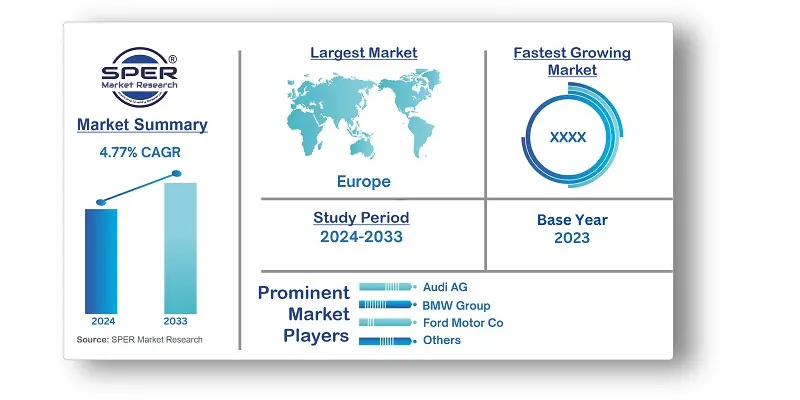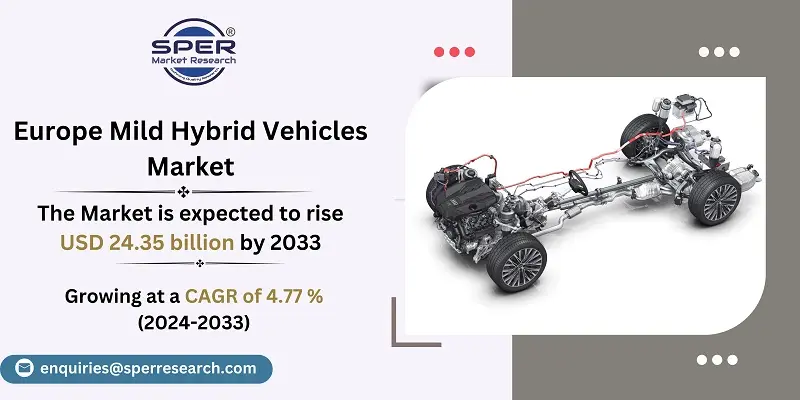
Europe Mild Hybrid Vehicles Market Growth, Size, Trends, Share, Revenue and Future Outlook
Europe Mild Hybrid Vehicles Market Size- By Battery Type, By Vehicle Type- Regional Outlook, Competitive Strategies and Segment Forecast to 2033
| Published: Mar-2024 | Report ID: AMIN2494 | Pages: 1 - 151 | Formats*: |
| Category : Automotive & Transportation | |||
- In November 2023: Toyota introduced the Hilux, a lifestyle pickup truck with a mild-hybrid diesel engine for European markets. Hilux has a 48V mild hybrid system and a 204PS 2.8-litre four-cylinder diesel engine. In India, the Hilux is available with the same diesel engine combined with a 6-speed manual or 6-speed automatic transmission.
- In June 2023: Volkswagen made the next generation Tiguan worldwide public. It features a variety of powertrain options, including plug-in hybrid systems (eHybrid), mild hybrid turbo petrol engines (eTSI), turbo diesel engines (TDI), and turbo petrol engines (TSI). The world premiere of the Tiguan took place in Wolfsburg, Germany.


| Report Metric | Details |
| Market size available for years | 2020-2033 |
| Base year considered | 2023 |
| Forecast period | 2024-2033 |
| Segments covered | By Battery Type, By Vehicle Type |
| Regions covered | Germany, France, Italy, Spain, UK, Rest of Europe |
| Companies Covered | Audi AG, BMW Group, Ford Motor Co., Hyundai Motor Company, Kia Motors Company, Mercedes-Benz, Mitsubishi Motors, Nissan Motors Co., Toyota Motors, Volkswagen AG, Volvo Group, Others. |
- Urban Commuters
- Eco-conscious Consumers
- Fleet Managers
- Government Agencies and Municipalities
- Automotive Enthusiasts
- Taxi and Ride-sharing Companies
- Corporate Car Fleets
| By Battery Type: |
|
| By Vehicle Type: |
|
| By Region: |
|
- Europe Mild Hybrid Vehicles Market Size (FY’2024-FY’2033)
- Overview of Europe Mild Hybrid Vehicles Market
- Segmentation of Europe Mild Hybrid Vehicles Market By Battery Type (Less than, Battery, 48V Battery, Above 48V Battery)
- Segmentation of Europe Mild Hybrid Vehicles Market By Vehicle Type (Passenger Cars, Commercial Vehicles)
- Expansion Analysis of Europe Mild Hybrid Vehicles Market
- Problems and Obstacles in Europe Mild Hybrid Vehicles Market
- Competitive Landscape in the Europe Mild Hybrid Vehicles Market
- Impact of COVID-19 and Demonetization on Europe Mild Hybrid Vehicles Market
- Details on Current Investment in Europe Mild Hybrid Vehicles Market
- Competitive Analysis of Europe Mild Hybrid Vehicles Market
- Prominent Players in the Europe Mild Hybrid Vehicles Market
- SWOT Analysis of Europe Mild Hybrid Vehicles Market
- Europe Mild Hybrid Vehicles Market Future Outlook and Projections (FY’2024-FY’2033)
- Recommendations from Analyst
1.1. Scope of the report1.2. Market segment analysis
2.1. Research data source2.1.1. Secondary Data2.1.2. Primary Data2.1.3. SPER’s internal database2.1.4. Premium insight from KOL’s2.2. Market size estimation2.2.1. Top-down and Bottom-up approach2.3. Data triangulation
4.1. Driver, Restraint, Opportunity and Challenges analysis4.1.1. Drivers4.1.2. Restraints4.1.3. Opportunities4.1.4. Challenges4.2. COVID-19 Impacts of the Europe Mild Hybrid Vehicles Market
5.1. SWOT Analysis5.1.1. Strengths5.1.2. Weaknesses5.1.3. Opportunities5.1.4. Threats5.2. PESTEL Analysis5.2.1. Political Landscape5.2.2. Economic Landscape5.2.3. Social Landscape5.2.4. Technological Landscape5.2.5. Environmental Landscape5.2.6. Legal Landscape5.3. PORTER’s Five Forces5.3.1. Bargaining power of suppliers5.3.2. Bargaining power of buyers5.3.3. Threat of Substitute5.3.4. Threat of new entrant5.3.5. Competitive rivalry5.4. Heat Map Analysis
6.1. Europe Mild Hybrid Vehicles Market Manufacturing Base Distribution, Sales Area, Product Type6.2. Mergers & Acquisitions, Partnerships, Product Launch, and Collaboration in Europe Mild Hybrid Vehicles Market
7.1. Europe Mild Hybrid Vehicles Market Value Share and Forecast, By Battery Type, 2024-20337.2. Less than 48V Battery7.3. 48V Battery7.4. Above 48V Battery
8.1. Europe Mild Hybrid Vehicles Market Value Share and Forecast, By Vehicle Type, 2024-20338.2. Passenger Cars8.3. Commercial Vehicles
9.1. Europe Mild Hybrid Vehicles Market Size and Market Share
10.1. Europe Mild Hybrid Vehicles Market Size and Market Share By Battery Type (2020-2026)10.2. Europe Mild Hybrid Vehicles Market Size and Market Share By Battery Type (2027-2033)
11.1. Europe Mild Hybrid Vehicles Market Size and Market Share By Vehicle Type (2020-2026)11.2. Europe Mild Hybrid Vehicles Market Size and Market Share By Vehicle Type (2027-2033)
12.1. Europe Mild Hybrid Vehicles Market Size and Market Share By Region (2020-2026)12.2. Europe Mild Hybrid Vehicles Market Size and Market Share By Region (2027-2033)12.3. Germany12.4. France12.5. Italy12.6. Spain
12.7. UK12.8. Rest of Europe
13.1. Audi AG13.1.1. Company details13.1.2. Financial outlook13.1.3. Product summary13.1.4. Recent developments13.2. BMW Group13.2.1. Company details13.2.2. Financial outlook13.2.3. Product summary13.2.4. Recent developments13.3. Ford Motor Co.13.3.1. Company details13.3.2. Financial outlook13.3.3. Product summary13.3.4. Recent developments13.4. Hyundai Motor Company13.4.1. Company details13.4.2. Financial outlook13.4.3. Product summary13.4.4. Recent developments13.5. Kia Motors Company13.5.1. Company details13.5.2. Financial outlook13.5.3. Product summary13.5.4. Recent developments13.6. Mercedes-Benz13.6.1. Company details13.6.2. Financial outlook13.6.3. Product summary13.6.4. Recent developments13.7. Mitsubishi Motors13.7.1. Company details13.7.2. Financial outlook13.7.3. Product summary13.7.4. Recent developments13.8. Nissan Motors Co.13.8.1. Company details13.8.2. Financial outlook13.8.3. Product summary13.8.4. Recent developments13.9. Toyota Motors13.9.1. Company details13.9.2. Financial outlook13.9.3. Product summary13.9.4. Recent developments13.10. Volkswagen AG13.10.1. Company details13.10.2. Financial outlook13.10.3. Product summary13.10.4. Recent developments13.11. Volvo Group13.11.1. Company details13.11.2. Financial outlook13.11.3. Product summary13.11.4. Recent developments13.12. Others
SPER Market Research’s methodology uses great emphasis on primary research to ensure that the market intelligence insights are up to date, reliable and accurate. Primary interviews are done with players involved in each phase of a supply chain to analyze the market forecasting. The secondary research method is used to help you fully understand how the future markets and the spending patterns look likes.
The report is based on in-depth qualitative and quantitative analysis of the Product Market. The quantitative analysis involves the application of various projection and sampling techniques. The qualitative analysis involves primary interviews, surveys, and vendor briefings. The data gathered as a result of these processes are validated through experts opinion. Our research methodology entails an ideal mixture of primary and secondary initiatives.



Frequently Asked Questions About This Report
PLACE AN ORDER
Year End Discount
Sample Report
Pre-Purchase Inquiry
NEED CUSTOMIZATION?
Request CustomizationCALL OR EMAIL US
100% Secure Payment






Related Reports
Our Global Clients
Our data-driven insights have influenced the strategy of 200+ reputed companies across the globe.




















